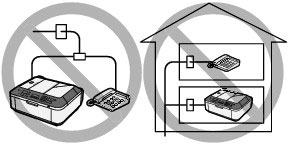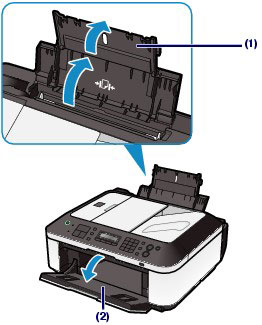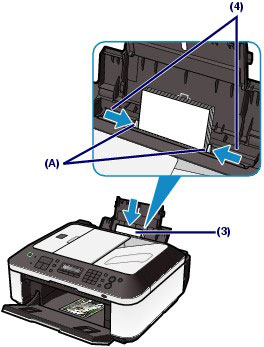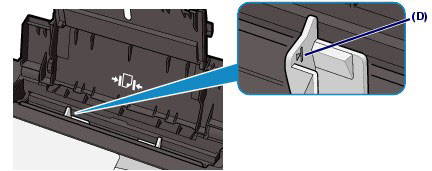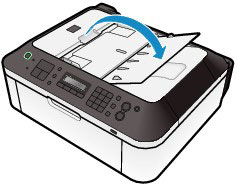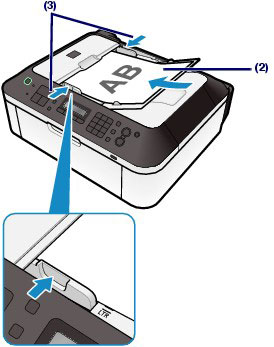Things to check when unable to send faxes - MX340
| Article ID: ART105467 | | | Date published: 05/11/2015 | | | Date last updated: 12/09/2015 |
Description
Solution
Cannot Send Faxes
|
Check the following when unable to send faxes |
|
Check 1: Is the power turned on?
A:ON button (POWER lamp) B:In Use/Memory lamp
|
|
Check 2: Is the document being sent from memory or the fax being received into memory? When the In Use/Memory lamp is flashing, a fax is being sent from/received into memory. Wait until the transmission/reception is complete. In the following cases, the machine is not able to print the received fax and will automatically store the fax in its memory.
important:
If you disconnect the power cord, all the documents stored in memory are deleted. Send or print necessary documents before disconnecting the power cord.
note:
When confirming, printing, or deleting a document stored in memory, you specify it by its transaction number. If you do not know the transaction number for your target document, print the list of documents first. Printing a Document in Memory If the machine was not able to send a fax or print a received fax, it stores the unsent or unprinted fax in its memory. If an error occurred during a fax transmission, the document is not stored in memory. You can print a list of stored documents (the memory list) or print a specified document.
note:
The memory list shows the transaction number of the unsent or unprinted fax (TX/RX NO.), transaction mode, recipient's number, and the date and time of the transaction.
1. Load paper. Refer to . 2. Press the FAX button, then press the Menu button. The Fax settings screen is displayed. 3. Use the 4. Print a specified document or memory list.
Use the The memory list stored in memory is printed. To print a specified document: 1. Use the 2. Use the Numeric buttons, or the
note:
No mark: Indicates a black and white document.
&: Indicates the machine is receiving/printing a color document.
3. Use the If you select Yes, only the first page of the document will be printed. If you select No, all the pages of the document stored in memory will be printed. To print other documents, repeat the procedure from steps 2 and 3. 4. Press the Back button or Stop button.
note:
1. Load paper. Refer to . 2. Press the FAX button, then press the Menu button. The Fax settings screen is displayed. 3. Use the 4. Use the 5. Use the
note:
Deleting a Document in Memory
1. Press the FAX button, then press the Menu button. The Fax settings screen is displayed. 2. Use the 3. Use the 
4. Use the 
note:
No mark: Indicates a black and white document.
&: Indicates the machine is receiving/printing a color document.
5. Use the To delete other documents, repeat the procedure from steps 4 and 5. 6. Press the Back button or Stop button.
1. Press the FAX button, then press the Menu button. The Fax settings screen is displayed. 2. Use the 3. Use the 4. Use the
note:
This function is not available while the machine is receiving a fax. To save a document on a USB flash drive You can save sent/received faxes on a USB flash drive as PDF files using the Operation Panel of the machine.
important:
1. Press the FAX button, then press the Menu button. The Fax settings screen is displayed. 2. Insert the USB flash drive into the Direct Print Port. 3. Use the 4. Use the
All the documents are saved on the USB flash drive.
Proceed to step 5. 5. Use the
The specified document is saved on the USB flash drive.
note:
No mark: Indicates a black and white document.
&: Indicates the machine is receiving/printing a color document. While the transaction number is displayed, pressing the 6. Use the To save other documents, repeat the procedure from steps 5 and 6. 7. Press the Back button or Stop button.
note:
- Folder name: CANON_SC\FAXDOC\0001 - File name (file extension: PDF): Running numbers, starting from FAX_0001 - File date: The date and time of saving as set in the machine. Importing Faxes Saved on a USB Flash Drive to the Computer You can import faxes saved on a USB flash drive to the computer. After saving faxes, connect the USB flash drive to the computer, then import the data using Windows Explorer.
|
|
Check 3: Is the telephone line connected to the External Device Jack? Reconnect it to the Telephone Line Jack. Refer to your setup manual.
If you still cannot send a fax, there is a problem with the telephone line. Contact your telephone company and the manufacturer of your terminal adapter or telephone adapter. For the basic connection of the machine, refer to the printed manual: Getting Started. This guide describes other typical connections. The machine cannot send/receive faxes if the connection is incorrect. Connect the machine correctly. important:
If the Power Disconnects Unexpectedly
If the power disconnects, the following will apply:
Connecting Various Lines These are examples and could not be guaranteed to suit every connecting condition. For details, refer to the instruction manual supplied with the network device (control devices such as an xDSL (Digital Subscriber Line) modem or terminal adapter) you are connecting to this machine. important:
Do not connect fax machines and/or telephones in parallel (US and Canada only)
- If you pick up the handset of the telephone that is connected in parallel during fax transmission or reception, the fax image may be corrupted or a communication error may occur. - Such services as Caller ID, etc. may not operate properly on the telephone.
note:
Connecting the telephone
(A) Digital Subscriber Line (B) xDSL modem (splitter may not be built-in to the modem) (C) WAN (Wide Area Network) (D) Broadband router compatible with Internet Telephone (E) Computer (F) Telephone or answering machine (G) LAN (Local Area Network) (H) TEL (I) LINE *Port configurations and names may vary depending on the product. note:
(A)Digital Subscriber Line (B) xDSL modem (splitter may not be built-in to the modem) (C) Computer (D) Telephone or answering machine important:
When the splitter is not built-in to the modem, do not branch the telephone line before the splitter (wall side). And also, do not connect splitters in parallel. The machine may not be able to operate properly. note:
When connecting to the xDSL line, select the same line type as you are subscribing to in Telephone line type. See Setting the Telephone Line Type.
For details on ISDN (Integrated Service Digital Network) connection and settings, refer to the manuals supplied with your terminal adapter or dial-up router.
Setting the Telephone Line Type Before using your machine, make sure you set the correct telephone line type for your telephone line. If you are unsure of your telephone line type, contact your telephone company. For xDSL or ISDN connections, contact the telephone company or service provider to confirm your line type. note:
1. Display the Telephone line type screen. (1) Press the FAX button, and press the Menu button. The Fax settings menu will appear. (2) Use the The FAX user settings menu will appear. (3) Use the 
2. Select the telephone line type. (1) Use the
Rotary pulse: Suitable for pulse dialing. Touch tone: Suitable for tone dialing. (2) Press the OK button. 3. Press the FAX button to return to the fax standby screen.
|
|
Check 4: Is the telephone line type set correctly? Check the telephone line type setting and change it as necessary.
The machine cannot send/receive faxes if the connection is incorrect. Connect the machine correctly. important:
If the Power Disconnects Unexpectedly
If the power disconnects, the following will apply:
Connecting Various Lines
These are examples and could not be guaranteed to suit every connecting condition. For details, refer to the instruction manual supplied with the network device (control devices such as an xDSL (Digital Subscriber Line) modem or terminal adapter) you are connecting to this machine. important:
Do not connect fax machines and/or telephones in parallel (US and Canada only)
- If you pick up the handset of the telephone that is connected in parallel during fax transmission or reception, the fax image may be corrupted or a communication error may occur. - Such services as Caller ID, etc. may not operate properly on the telephone.
note:
Connecting the telephone
Connecting to an Internet Telephone
(A) Digital Subscriber Line (B) xDSL modem (splitter may not be built-in to the modem) (C) WAN (Wide Area Network) (D) Broadband router compatible with Internet Telephone (E) Computer (F) Telephone or answering machine (G) LAN (Local Area Network) (H) TEL (I) LINE *Port configurations and names may vary depending on the product. note:
(A)Digital Subscriber Line (B) xDSL modem (splitter may not be built-in to the modem) (C) Computer (D) Telephone or answering machine important:
When the splitter is not built-in to the modem, do not branch the telephone line before the splitter (wall side). And also, do not connect splitters in parallel. The machine may not be able to operate properly. note:
When connecting to the xDSL line, select the same line type as you are subscribing to in Telephone line type. See Setting the Telephone Line Type.
For details on ISDN (Integrated Service Digital Network) connection and settings, refer to the manuals supplied with your terminal adapter or dial-up router. Setting the Telephone Line Type Before using your machine, make sure you set the correct telephone line type for your telephone line. If you are unsure of your telephone line type, contact your telephone company. For xDSL or ISDN connections, contact the telephone company or service provider to confirm your line type. note:
1. Display the Telephone line type screen. (1) Press the FAX button, and press the Menu button. The Fax settings menu will appear. (2) Use the (3) Use the 
2. Select the telephone line type. (1) Use the
Rotary pulse: Suitable for pulse dialing. Touch tone: Suitable for tone dialing. (2) Press the OK button. 3. Press the FAX button to return to the fax standby screen.
|
|
Check 5: Is Hook key setting set to Disable? When you send a fax manually, dial the number with Hook key setting set to Enable, or dial the number using the telephone connected to the machine |
|
Check 6: Is Dial tone detect set to ON? |
|
Check 7: Is the fax number registered correctly for speed dialing? Make sure that the fax number is registered correctly for speed dialing. Speed dialing allows you to dial fax/telephone numbers by simply pressing a few buttons. The following speed dialing methods are available:
Register a fax/telephone number for coded speed dialing. To dial the number, press the Coded Dial button, then enter the two-digit code assigned to that number, or use the
See Registering Coded Speed Dial Numbers, below
Register two or more registered coded speed dial numbers for group dialing. You can send the same document to all members in that group.
See Registering Group Dial Numbers, below
Registering Coded Speed Dial Numbers
Before you can use the coded speed dialing feature, you need to register the recipients' numbers.
1. Press the FAX button, then press the Menu button.
2. Use the

3. Use the

4. Use the

5. Use the
6. Use the Numeric buttons to enter the fax/telephone number (max. 60 digits (40 digits for the US, Canada, and Korea), including spaces) you want to register, then press the OK button.

note:
7. Press the OK button when Name is displayed on the LCD, then use the Numeric buttons to enter a name for the coded speed dial code (max. 16 characters, including spaces).
8. Press the OK button to finalize registration. note:
Registering Group Dial Numbers
To send the same document to several recipients successively, select the numbers you registered to the coded speed dial codes and register them to a group dial.
1. Press the FAX button, then press the Menu button.
2. Use the
3. Use the

4. Use the
note:
You can register a group under an unoccupied coded speed dial code. 5. Press the Coded Dial button, then use the
If Enter first letter is displayed on the LCD, press one of the Numeric buttons, use the
note:
6. Press the OK button after registering the codes to the group, then use the Numeric buttons to enter a name for the group (max. 16 characters, including spaces). note:
7. Press the OK button to finalize registration. note:
|
|
Check 8: Does an error occur during transmission?
|
|
Check 9: Is the telephone line connected correctly?
Check that the telephone line is connected correctly to the proper jack. If so, then there is a problem with your telephone line. Contact your telephone company. The machine cannot send/receive faxes if the connection is incorrect. Connect the machine correctly. important:
If the Power Disconnects Unexpectedly
If the power disconnects, the following will apply:
Connecting Various Lines
These are examples and could not be guaranteed to suit every connecting condition. For details, refer to the instruction manual supplied with the network device (control devices such as an xDSL (Digital Subscriber Line) modem or terminal adapter) you are connecting to this machine. important:
Do not connect fax machines and/or telephones in parallel (US and Canada only)
- If you pick up the handset of the telephone that is connected in parallel during fax transmission or reception, the fax image may be corrupted or a communication error may occur. - Such services as Caller ID, etc. may not operate properly on the telephone.
note:
Connecting the telephone
Connecting to an Internet Telephone
(A) Digital Subscriber Line (B) xDSL modem (splitter may not be built-in to the modem) (C) WAN (Wide Area Network) (D) Broadband router compatible with Internet Telephone (E) Computer (F) Telephone or answering machine (G) LAN (Local Area Network) (H) TEL (I) LINE *Port configurations and names may vary depending on the product. note:
(A)Digital Subscriber Line (B) xDSL modem (splitter may not be built-in to the modem) (C) Computer (D) Telephone or answering machine important:
When the splitter is not built-in to the modem, do not branch the telephone line before the splitter (wall side). And also, do not connect splitters in parallel. The machine may not be able to operate properly. note:
When connecting to the xDSL line, select the same line type as you are subscribing to in Telephone line type. See Setting the Telephone Line Type.
For details on ISDN (Integrated Service Digital Network) connection and settings, refer to the manuals supplied with your terminal adapter or dial-up router. Setting the Telephone Line Type Before using your machine, make sure you set the correct telephone line type for your telephone line. If you are unsure of your telephone line type, contact your telephone company. For xDSL or ISDN connections, contact the telephone company or service provider to confirm your line type. note:
1. Display the Telephone line type screen. (1) Press the FAX button, and press the Menu button. The Fax settings menu will appear. (2) Use the (3) Use the 
2. Select the telephone line type. (1) Use the
Rotary pulse: Suitable for pulse dialing. Touch tone: Suitable for tone dialing. (2) Press the OK button. 3. Press the FAX button to return to the fax standby screen.
|
|
Check 10: Is the document loaded properly? Remove the document, then reload it on the Platen Glass or in the ADF.
Loading Plain Paper / Photo Paper important:
If you cut plain paper into small size such as 4" x 6" / 10 x 15 cm, 4" x 8" / 101.6 x 203.2 mm, 5" x 7" / 13 x 18 cm, or 2.16" x 3.58" / 55.0 x 91.0 mm (Card size) to perform trial print, it can cause paper jams. note:
1. Prepare paper. Align the edges of paper. If paper is curled, flatten it. 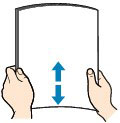
note:
2. Load paper. (1) Open the Paper Support, and open the support as an extension. (2) Open the Paper Output Tray gently.
(3) Slide the Paper Guides (A) to open them, and load the paper in the center of the Rear Tray WITH THE PRINT SIDE FACING YOU. (4) Slide the Paper Guides (A) to align them with sides of the paper stack. Do not slide the Paper Guides too hard. The paper may not be fed properly.
important:
note:
note:
After loading paper
Loading Documents in the ADF You can load documents to copy, fax, or scan in the ADF. note:
To scan a document at optimum quality, load it on the Platen Glass. 1. Make sure that any original has been removed from the Platen Glass. 2. Load a document in the ADF. (1) Open the Document Tray.
(2) Insert the document in the Document Tray until you hear a beep sound. Load the document WITH THE SIDE TO SCAN FACING UP in the Document Tray. note:
When you set the alarm to be silent in Device user settings of Device settings, the alarm will not beep even if the document is inserted in the Document Tray. (3) Adjust the Document Guides to match the width of the document. Do not slide the Document Guides too hard. The document may not be fed properly.
|
|
Check 11: Does a printer error occur?
If you are in a hurry, press the Stop button to close the message, then send the fax. |



 button to select Memory reference, then press the OK button.
button to select Memory reference, then press the OK button. : Indicates a color document.
: Indicates a color document. : Indicates the machine is receiving/printing a black and white document.
: Indicates the machine is receiving/printing a black and white document.
